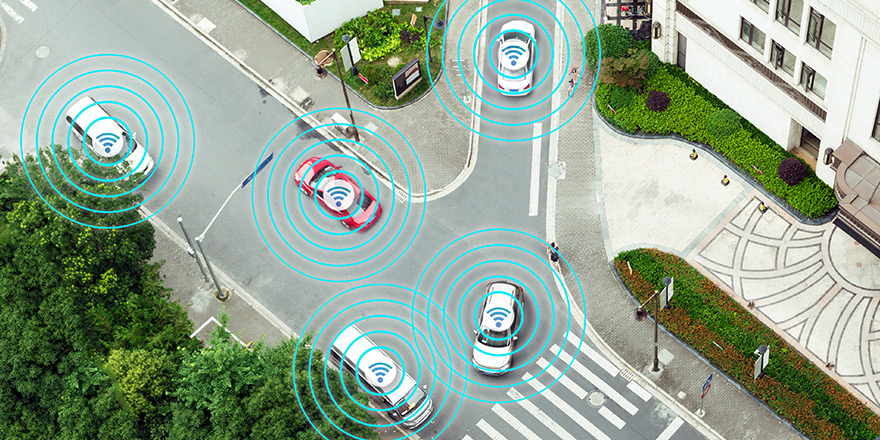Solving signal problems for self-driving cars
Read here how Software AG worked with the Cartox2 project to help self-driving cars go where the strongest signals are, avoiding accidents.

Self-driving cars… love them or hate them, they are coming to a city near you. In Germany, the Bundestag has just passed a law allowing the use of self-driving cars.
Autonomous vehicles offer great opportunities and at the same time present us with many challenges. For example, without sufficient signal strength, autonomous cars’ systems cannot communicate with each other or receive signals and warnings. If one car’s systems are trying to warn other cars of an accident two kilometers away, but there is no mobile or wireless signal, the other cars will end up in the same traffic jam.
A signal drop can also have safety-critical consequences. If your car is driving at speed toward a just-collapsed bridge and loses the signal, you could risk going into the river. Cities, too, need an intelligent and safe traffic infrastructure. A weak or dropped signal can lead to something minor like getting caught in traffic, or something major like hitting a quickly merging cyclist.
The Cartox2 project
To help solve some of these nagging issues, Software AG was part of the Cartox2 research project funded by the German Federal Ministry of Transport and Digital Infrastructure with five other partners: CETECOM, Fraunhofer Institute for Transportation and Infrastructure Systems IVI, HRD Consulting, MechLab Engineering and Technical University of Dresden.
Cartox2 collects and processes information about car-to-car connectivity (C2C), network coverage for car-to-x communication (C2X), and data routing to and between edge clouds, the access points of the cloud environment. Cartox2 merges hybrid communication and positioning data with other geospatial data on a big data platform. It enriches static with real-time information to create novel services and business models with data analysis algorithms.
Software AG’s role was to integrate, prepare, analyze, and visualize data. The team succeeded in creating an exciting modular prototype using Software AG’s Cumulocity IoT with its visual analytics and streaming analytics applications, along with Angular web technology and container virtualization with Docker and NginX security.
Visualize signal strength
With the help of Cumulocity IoT, we offer an interesting service for visualization here, using data from the Dresden area that was previously measured by a project partner. Software AG took this data, analyzed it and made it available in a visualized form with Cumulocity IoT.
The user logs in via a browser and clicks on locations on a street map or enters the coordinates. The user immediately learns whether the signal strength there is high enough, i.e. whether autonomous driving is possible.
But the prototype can do much more, for example with the RSSI (Received Signal Strength Indicator) routing feature Cumulocity IoT calculates routes with the best signal strength for Dresden. It shows the so-called line-of-sight propagation, i.e. the straight-line propagation of the signals to the receiver. This is because the user wants to “see” where there are obstacles to good signal strength, even at unclear intersections.
The prototype also visualizes access to edge clouds. Where cars cannot communicate directly with each other, they request information from edge clouds that other car systems have previously reported to them. This works via Roadside Units (RSUs), hardware installed at the side of the road that Cumulocity IoT displays via precise coordinates.
Assessing accident risks
Cartox2 can also identify accident blackspots. These occur when there is a lack of radio coverage, especially for highly automated vehicles.
And what’s more: with one click on an accident location, the user receives information about which vehicle caused an accident, when, and under what conditions (of course under protection of data privacy).
The Cartox2 service platform enables accident researchers to evaluate already known accident blackspots according to new criteria and to assess risks. In addition, it should become possible in the future to predict previously unknown accident black spots that will arise with future vehicle generations.
Fit for autonomous driving
The advantages of such a visualization and the potential user types are obvious: Decision-makers in municipalities can use Cartox2 to make their city fit for autonomous driving. Signal strengths can be recorded and optimized. Traffic can be rerouted more quickly in the event of weak signal strength, accidents or high traffic volumes. Accidents can be avoided through the collected and visualized data by targeted traffic guidance, as can increased CO2 emissions.
Bus operators also benefit from the system. They receive information about which route makes economic and ecological sense for autonomous driving and can plan their routes in consultation with the municipality. This valuable data will be public and easily accessible, including to citizens’ groups with their local concerns. The use cases are promising, as is the potential of this platform.
Click here to learn what Software AG’s R&D department is working on.
Click below to learn more about the Cartox2 program (in German only).